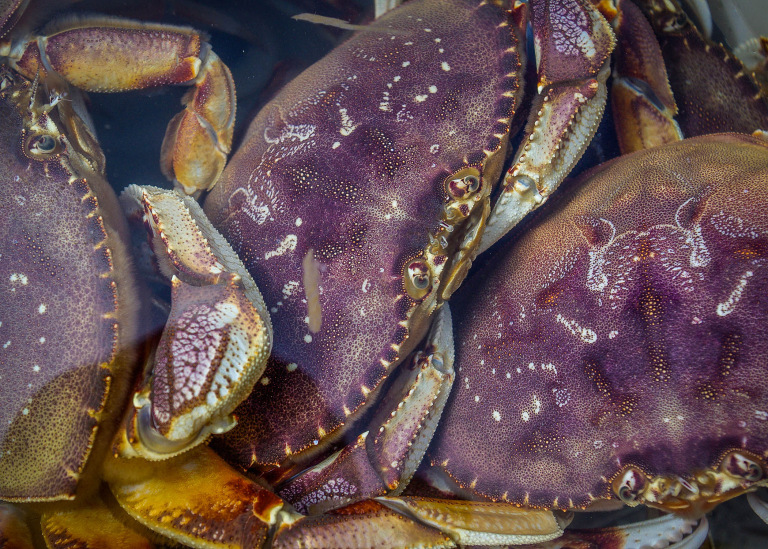
Catching Crabs with a Chicken Leg?

by Carrie Wilson
2-23-2017
Website
Question: California regulations stipulate that taking crustaceans by “hook and line” is not a legal method of take. So what about a baited line with no hook (e.g. a chicken leg) with a hand line tied to it? As long as I use my hands to take the crab and not a net, is a baited line allowed to lure the crab within reach? (Patrick M.)
Answer: Ocean sport fishing regulations specify what gear may be used to take saltwater crustaceans, and any “nets, traps or other appliances” not specified in the following section are prohibited methods of take (California Code of Regulations Title 14, section 29.80(a)(2)). A baited line without a hook is not a legal method of take, but here’s an idea … you could tie a chicken leg to a loop trap, or make the chicken leg into a loop trap by attaching up to six loops (slip knots) to the bait, and snare a crab this way. This method of a line attached to a chicken leg would be legal to use!
Looking for sustainable and ethical wild game for restaurant
Question: I am a chef and we will open a new, very small, specialized Japanese restaurant in Los Angeles. I am looking for sustainable and ethical wild game. Could you please help me find a hunter that deals with restaurants like ours? (Ni L.)
Answer: It is illegal for anyone to buy, sell or trade any sport-taken wild game meat in California. There are businesses that import “exotic” meats, and they are inspected and regulated by the United States Department of Agriculture (USDA). According to the USDA, “Game meats that do not have a mark of inspection cannot be sold. This is the case for game meat harvested by a recreational hunter. The inspection and processing requirements will not be met and thus the meat cannot be sold.”
Lifetime licenses for a 3-year-old
Question: I just purchased a lifetime fishing license for my 3-year-old son and would like to purchase his lifetime hunting license as well. Do I have to wait until he is old enough to take and pass his hunters safety class first? (Anxious dad)
Answer: Great question! You will be able to purchase the lifetime hunting license now to lock in the price but he will not be able to use it until he completes his hunter safety class. Once you buy the license, our License and Revenue Branch will send you confirmation of your purchase. After your son takes the class (usually at nine years or older) and gives us the certificate showing that he has passed his test, like magic, his profile will show that he has an active lifetime hunting license and he will be able to use it.
Likewise, his lifetime fishing license may not show up in his profile until he turns 16 (when he will need to have a fishing license to fish). If you bought one of the add-on packages that include fishing report cards, he will have access to those before his 16th birthday because the report cards are necessary for anglers of all ages.
Good luck and I hope you have many happy years of hunting and fishing with your son!
Catching bait from the piers and bays
Question: What are the legal methods allowed for catching live bait? I have used sabiki type rigs when fishing for mackerels and sardines, but recently I’ve started fishing the bays. Is it legal to use homemade minnow traps in the bays (e.g. Mission Bay and San Diego Bay) to catch smelts to use for bait, or can I only use those bait nets available at local sport fishing retailers for catching bait fish? I am hoping to catch baits south of Point Conception. (Charles P.)
Answer: Baited traps are not authorized for the take of bait fish south of Point Conception. The only authorized methods of take for bait fish are using dip nets, baited hoop nets not greater than 36 inches in diameter, by hook and line or by hand. “Dip nets of any size and baited hoop nets not greater than 36 inches in diameter may be used to take herring, Pacific staghorn sculpin, shiner surfperch, surf smelt, topsmelt, anchovies, shrimp and squid. Hawaiian-type throw nets may be used north of Point Conception to take such species” (CCR Title 14, section 28.80). When taking other species of bait fish, your hand-held dip net must be not more than six feet in greatest diameter, excluding the handle (CCR Title 14, section 1.42).
Carrie Wilson is a marine environmental scientist with the California Department of Fish and Wildlife. While she cannot personally answer everyone’s questions, she will select a few to answer each week in this column. Please contact her at CalOutdoors@wildlife.ca.gov.
Website Hosting and Design provided by TECK.net